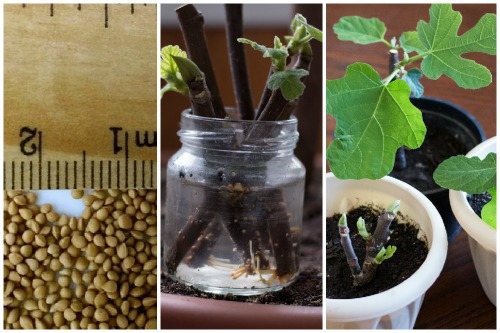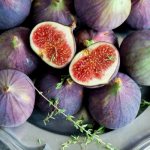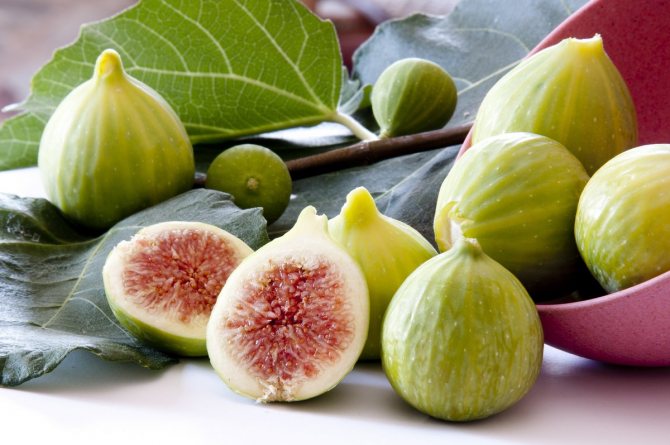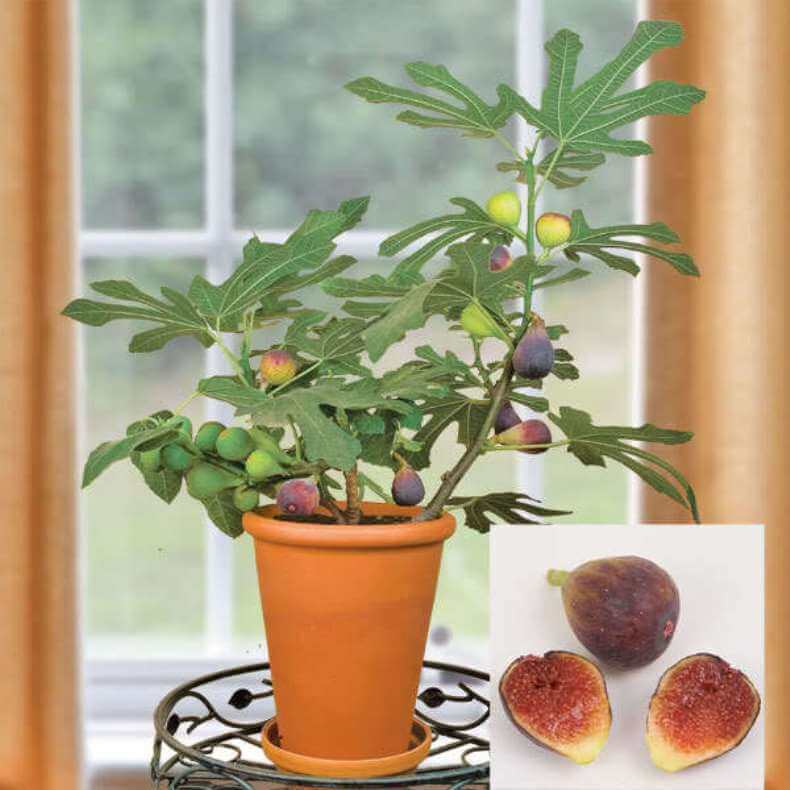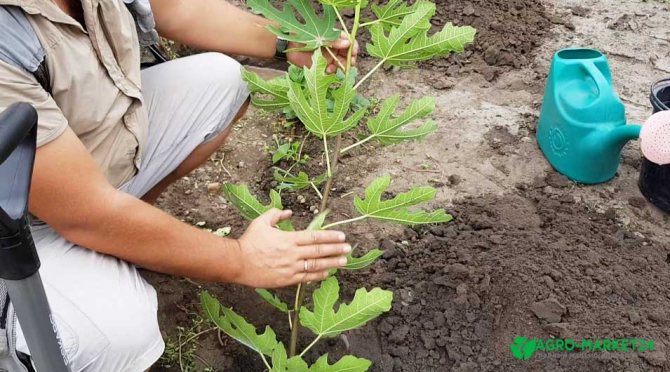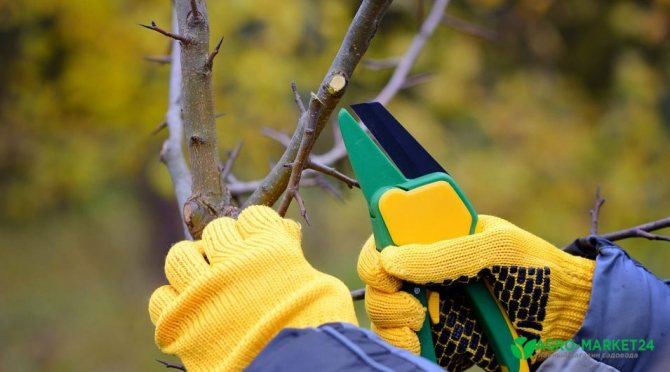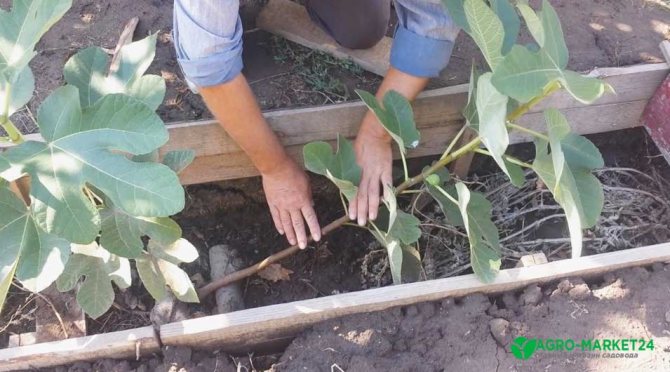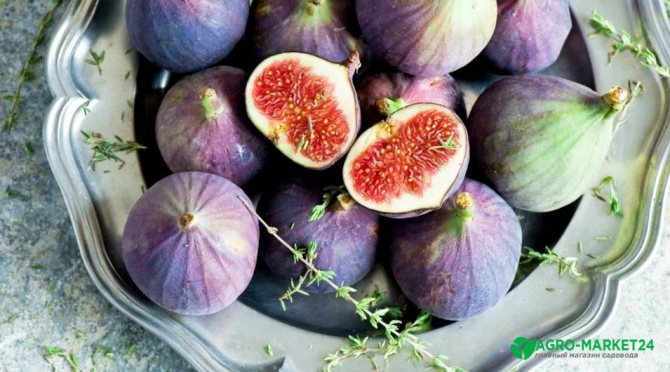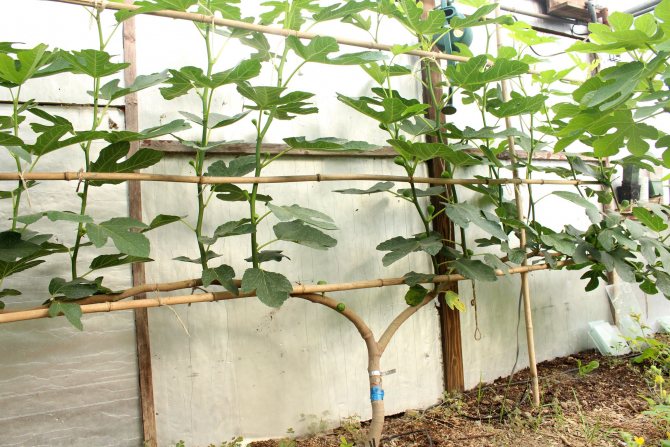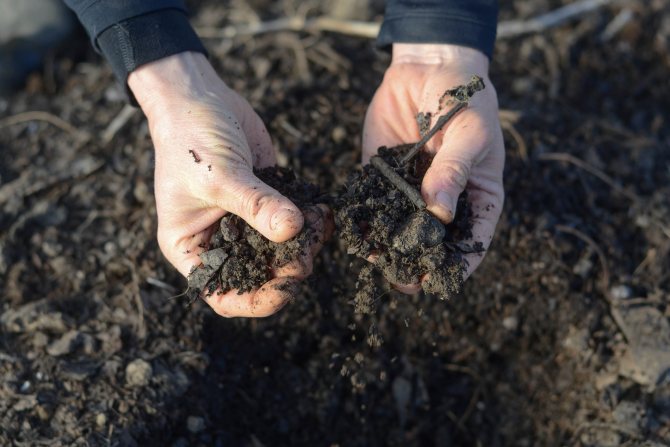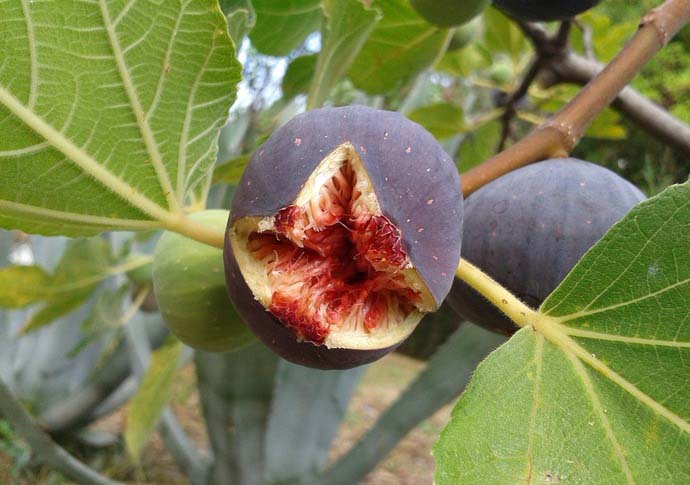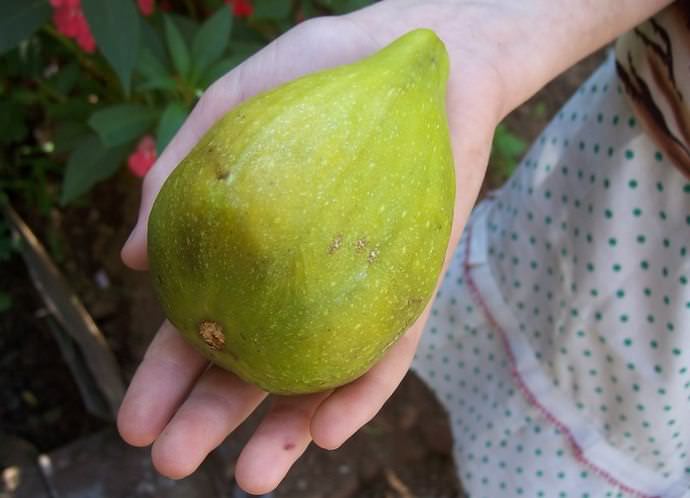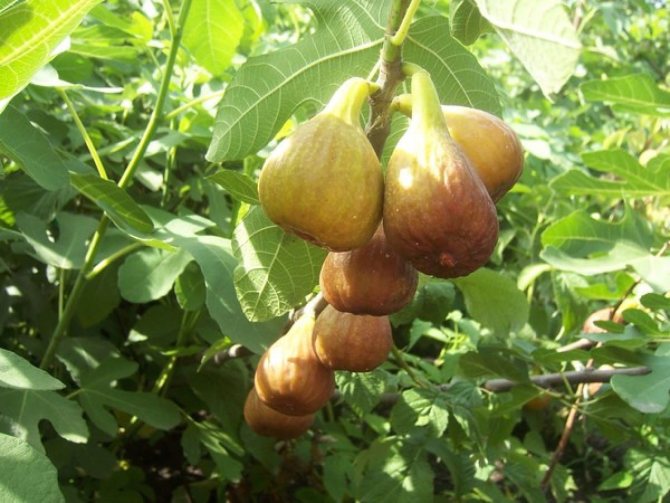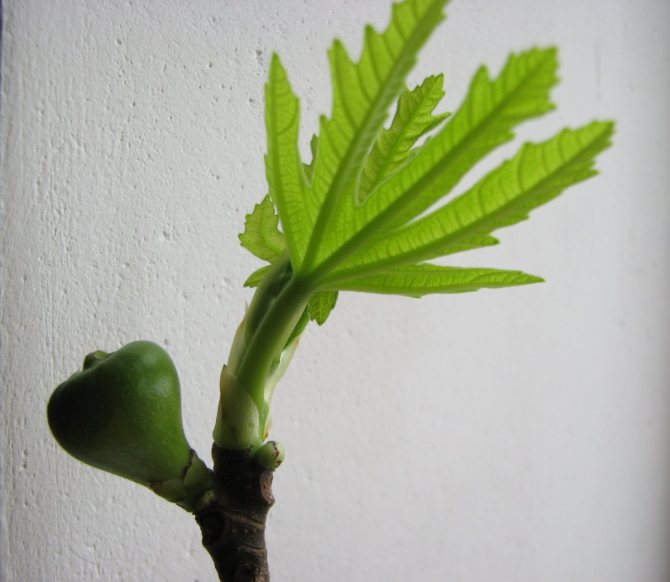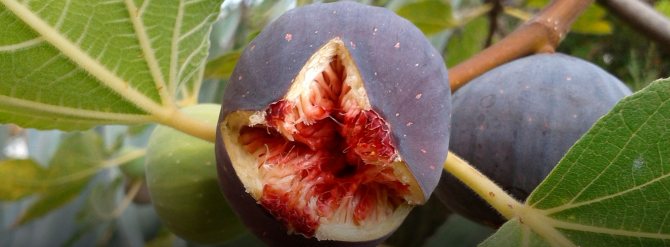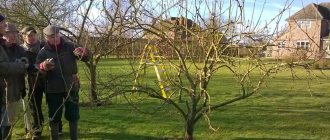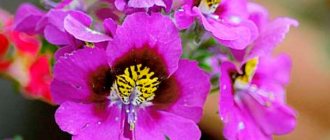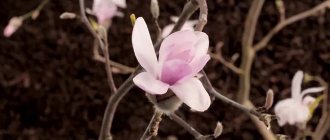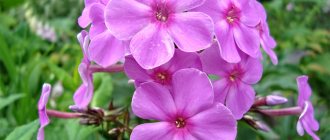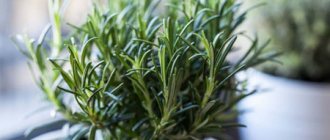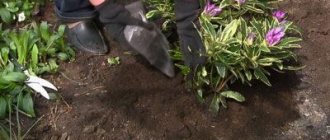Fig, or fig, fig tree, fig, ficus carica (Fikuscarica), wine berry - the oldest thermophilic plant growing on the Mediterranean and Black Sea coast up to 12 meters. Its fruits are delicious and very healthy. They contain a lot of vitamins A, B, C, trace elements, fiber, proteins and others. Figs are recommended as a remedy for anemia, they are used for cardiovascular diseases, for the treatment of colds, sore throats. It is a good diuretic. Recently, the mentioned southern tree is grown not only in the Caucasus and Central Asia, but also in the Crimea, Krasnodar Territory, in the south of Ukraine and even in the Moscow region.
Growing figs in the garden
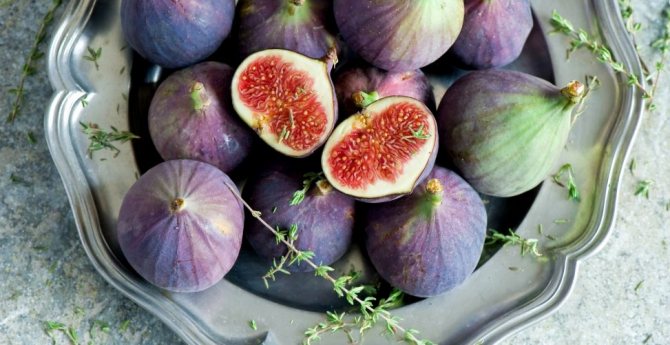
Figs are native to the Mediterranean and other countries with mild climates. We, residents of central and eastern Ukraine, are also not averse to joining the cultivation of exotic fruits, but here the question immediately arises: how will the thermophilic fig survive our cold winters? Is it possible to grow it in the garden and how to do it? As the experience of Ukrainian gardeners proves, with desire and hard work it is quite possible.
Fig (or fig tree, or fig) is one of the most ancient plants that man grows in culture. The Latin name "Ficus carica" indicates to us that the fig belongs to the genus Ficus. We meet the mention of him in the Bible. After all, it was with a leaf of this tree that Adam and Eve covered their nakedness after eating the fruit of the tree of knowledge. An unpretentious plant with beautiful large leaves attracted the attention of a person with its sweet, like honey, fruits. Delicious and tender, they are at the same time very nutritious and healthy, they can give you a quick satiety.
As mentioned above, many Ukrainian gardeners living in Kiev, Dnepropetrovsk, Kharkov and other regions have experience in growing this plant in open ground. We will talk about the features of agricultural technology for the regions of Ukraine in the article.
In places of their habitat, figs grow in the form of a contented large tree, but here it is grown by a bush.
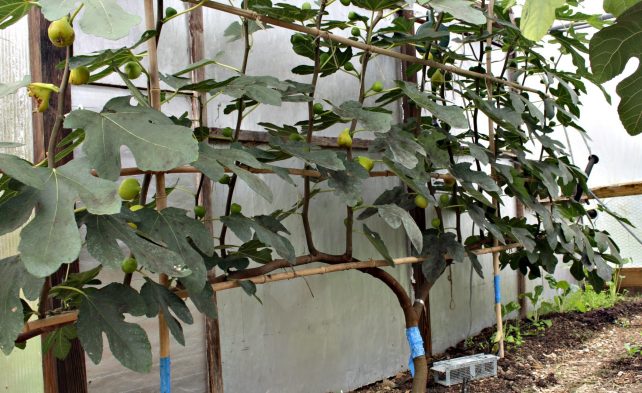

figs in cordon molding
bush-shaped figs
Growing methods
In places of its range, figs grow in the form of a contented large tree, but in our country they grow it as a bush. The main secret of successfully growing figs is to provide them with conditions for a successful wintering. For this, as a rule, it is grown in pits or trenches, which is convenient for a winter shelter of a heat-loving plant.
There are two main ways:
1. Growing at an angle of 45 °. The seedling is positioned so as to further facilitate the bending of the branches in front of their shelter.
2. Formation of a horizontal cordon. In this case, the seedling is planted vertically, the top is cut off, and the growing side shoots are carefully bent to the ground. They are placed in the form of sleeves directed along one line in opposite directions. From the buds on these shoots, vertically growing branches develop, on which the harvest will ripen.
Planting a seedling
First, choose the warmest, wind-protected spot in your garden and prepare a hole. A trench must be dug if you are going to plant several plants at once. This must be done in advance, since the process is quite laborious.
To plant one plant, dig a hole about 1.5 m long, 1 m wide and 60–80 cm deep. A deep hole for planting the seedling itself is not needed, since the root system of the figs is superficial.
For convenience, you can plant 2 plants at once, then increase the length of the trench to 2 m. Place the seedlings at opposite ends at an angle to the center of the trench. It is convenient to bend down the shoots growing towards each other and make a common shelter for the winter. Also, this arrangement saves space and labor costs.
Fold the top fertile layer of earth separately to later fill it into the planting hole. When the pit is prepared, pour 1.5 buckets of humus or compost, 200 g of superphosphate, 200 g of potash fertilizers (wood ash can be used) on the bottom, then a layer of prepared fertile soil.
Form a small mound in the hole on which to distribute the roots of the seedling, cover with soil, compact and water abundantly. As for fertilizers, they can not be used, because in nature, figs grow even on scanty stony soils. Therefore, sand and small stones can be added to the soil mixture.
Figs are planted in open ground in late April - early May, when the threat of night frosts has finally passed. When growing a large number of plants, the trench must be positioned in the direction from east to west in order for the sunlight to be maximum.
Figs are planted in open ground in late April - early May, when the threat of night frosts has finally passed.
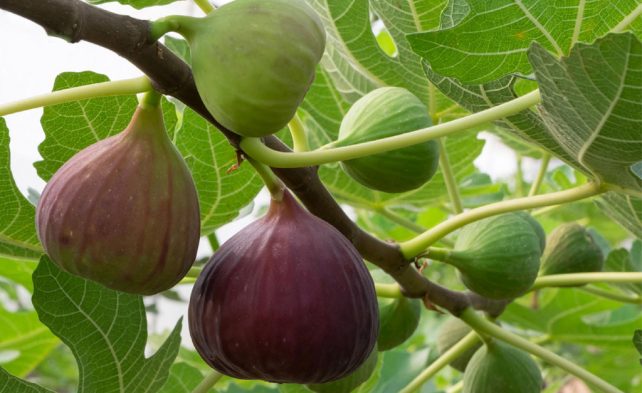

sweet figs
Care and shaping
After planting, the seedlings must be watered often and abundantly at first, then a couple of times a month. Maintain the height of the bush by pruning no higher than 2 m. Pay special attention to pruning and crown formation. The crown needs to be thinned so that the fruits are well illuminated by the sun and ripen.
How figs winter
In autumn, after leaf fall, in late October - early November, fig bushes growing at an angle can be started to gradually and carefully bend to the ground, trying not to break off the branches. Then tie them together and sprinkle with earth, dry leaves and other plant debris. With the onset of frost, cover with two layers of black spunbond, and after a while also with plastic wrap. Some gardeners build a low frame shelter made of polyethylene over the bushes. This is optional.
In the spring, with the onset of freezing temperatures, the shelter can be gradually removed. It is completely removed when stable warm weather is established without the threat of return frosts. Every year the branches are getting thicker, and it is difficult to bend them down, so you just need to cut such branches.
When is the harvest expected?
Fig is a fast-growing crop and begins to bear fruit in the second year after planting. In nature, the fig is a dioecious plant, that is, there are male and female trees. The pollination process is very complex, the main role in it is played by the blastophage wasp, which carries pollen, pollinating plants. Since this wasp does not live everywhere, breeders bred self-fertile - parthenocarpic varieties. It is these varieties that are commonly used in culture. This allows you to get a harvest even when growing one bush.
You cannot see a flower in the form we are accustomed to in a fig. One gets the impression that a small fruit is immediately formed, which grows and ripens. In fact, the fig flower develops in the axils of the leaves inside the spherical-thickened shoots with a hole at the top. The flowers are small and inconspicuous. Female fruit stems - figs - acquire rather large pear-shaped forms as they ripen.
Most varieties give two harvests per year: the first at the beginning of summer on the shoots of the last year, and the second in September - October on the current shoots. In our conditions, when growing in open ground, you need to focus on getting fruits in the fall.But when growing figs in a greenhouse, you can get two harvests per year. The moment of maturity of the fruit is determined by the color of the skin and its density. The ripe fruit has a characteristic color for the variety (green, brown, yellow or dark purple), it is soft to the touch.
Reproduction. Figs are easy to propagate using cuttings in the fall during pruning or early spring. Cuttings harvested in the fall are stored in the basement until mid-January. Then they germinate like grape cuttings.
The best fig varieties for Russia and Ukraine
Figs, or figs, have been grown for a long time, they can be eaten fresh, dried, they make jam and jams from it. Its numerous varieties are distinguished by ripening time, color, fruit size, taste, number of harvests per season.
When growing figs, it should be borne in mind that in natural conditions, it is pollinated mainly by blastophagous wasps, which are not found in our area. Self-fertile varieties of this plant are grown here in the open field. The most popular ones are presented in the following table.
| Variety name | Description of fruits | Characteristics of the variety |
| Kadota | Greenish-yellow, large with light creamy pulp, round, pear-shaped, weighing up to 58 grams, sugar over 20% | Comes from California, universal, medium-sized crown, spreading, transportable, frost-resistant (up to -27) |
| Turkish brown | Produces 2 crops in August and October. The first pear-shaped red-brown fruits weighing up to 58 grams, the second - rounded brown-purple weighing up to 43 grams | American origin, high yielding, medium trees, dessert |
| Abkhazian purple | Gray-purple, the first harvest in August - 80 grams, the second - in November, 50 grams, elongated ribbed shape, sugar - more than 20% | Medium-sized trees, dried fruit and table variety, originally from Tunisia |
| Crimean black | Oval, violet-blue with a thin, dense and pubescent skin and dark red flesh. The first harvest - in June - 80 grams each, the second - in September - 40 grams each | Early, versatile - drying, canning, jam. Bred in Nikitsky Botanical Garden |
| Date | Medium in size, pear-shaped, with a delicate, dense, variegated skin, green-purple, smooth with a dark red oily pulp. Ripen at the end of September, weigh 50 grams | Originally from Italy, versatile, vigorous tree |
| Chapla | Yellow-brown, pear-shaped, with red-pink flesh, juicy with a thin skin | Dessert, suitable for conservation, trees up to 6 meters high |
| Dalmatian | Pear-shaped, large: the first collection - 180 grams, the second - 130 grams. The skin is light yellow with white spots, the pulp is juicy, reddish, sweet and sour | Best table variety |
| Early gray | Round, light purple or brown, juicy and sweet, the first collection is 40 grams, the second is 30 grams | Early variety |
| Randino | Oval, light green, ribbed and oblong, sweet, the weight of the first collection is 100 grams, and the second - 50 grams | Suitable for conservation |
| Brunsovik | Large - up to 200 grams, pear-shaped, light green with juicy pulp, sweet | Early, high-yielding, frost-resistant (up to -27 degrees) |
Figs, or figs, have been known to mankind since time immemorial. These are southern heat-loving plants. But recently, many varieties have been bred that are successfully grown in temperate climatic zones, where you can get up to 10-15 kg of this tasty and healthy exotic fruit from a bush.
Planting Figs in the open field - crop care
Many gardeners dream of growing Figs on their plot, because this fruit tree, with good care, will delight you with delicate tasty fruits, they appear on the branches in three waves from April to May. Today I hasten to tell you how to grow this heat-loving culture in the middle zone, protect it from the cold in winter, and ensure long-term fruiting.
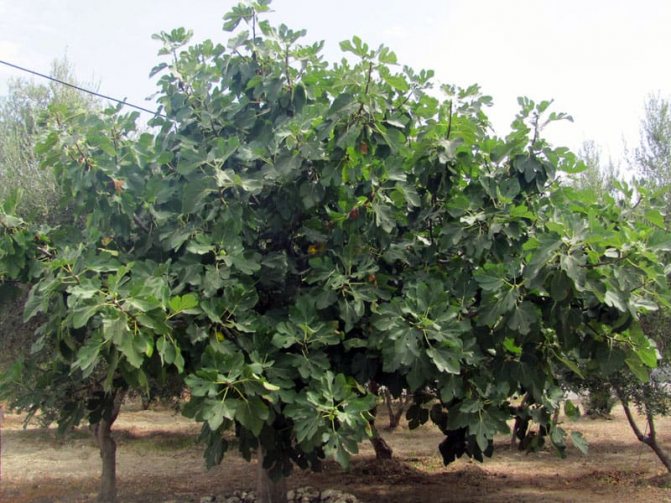

Which variety to choose?
Knowing how figs grow, one can draw conclusions which of the varieties will take root in non-tropical conditions, and which will not.
An important indicator is the winter hardiness of the plant. For our climate, special varieties were bred that are able to withstand the cold winter, frost and successfully wait until their favorite time comes - summer.
In addition, preference should be given to self-pollinated species, even in the subtropics there is only one species of wasps capable of pollination, and in our latitudes it does not live at all.
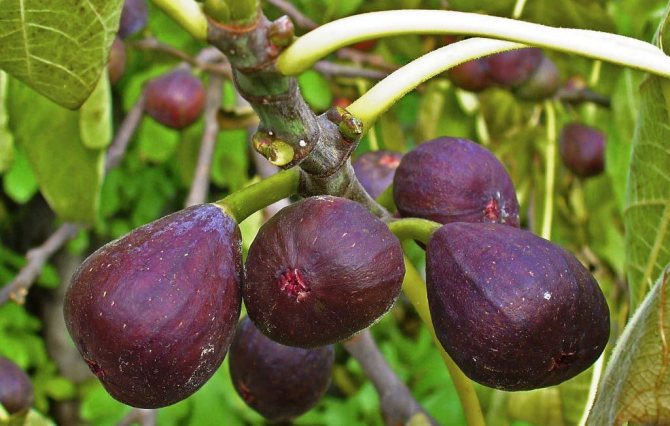

Based on such conditions and knowing the features of how to grow figs, the following varieties are suitable for a successful, fertile planting:
- "Abkhazian violet";
- "Crimean Black";
- "Pomorie";
- "Gray early";
- "Dalmatian";
- "Turkish brown".
Description of culture
The fruit tree is a deciduous species of the Ficus genus of the Mulberry family. Its homeland is the ancient region of Caria in Asia Minor. The plant has a smooth silvery bark, and its large foliage has a hard surface.
Fig is an exotic perennial (up to 300 years old) plant. Due to its relative unpretentiousness to the climate, it can adapt to different conditions.
During the flowering period, dioecious spherical flowers are formed on the shoots. Of these, in the third year of growth, nuts are formed with one seed inside. Their color ranges from yellow to charcoal ink.
Ripe figs have:
- size 5-8 cm in diameter;
- pear-shaped;
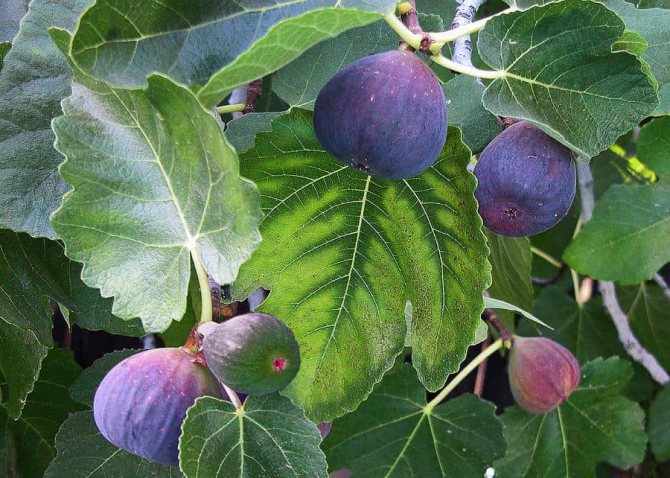

The fruits have a sugary-sweet taste; in an unripe form, they are not suitable for consumption due to the presence of a large volume of milky bitter juice.
Botanical features of figs
Anyone who has never seen a fig tree can safely imagine a rather sprawling, tall ficus with large cut leaves, numerous fruits resembling small pears in shape, light yellow or purple (depending on the variety). The fig tree has been known to man since ancient times and has been cultivated for about 5000 years.
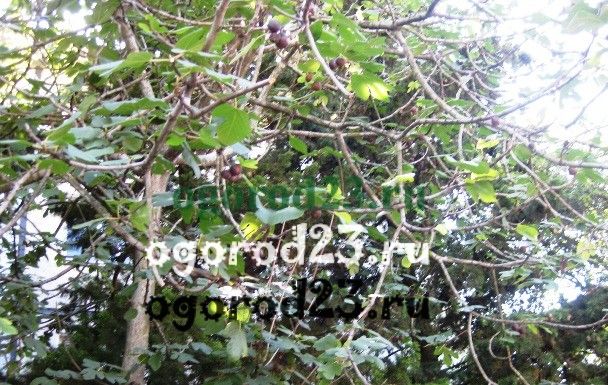

The fig tree is a long-lived tree - under favorable conditions it lives and bears fruit for over 300 years. The fig tree (F. carica), growing on the Black Sea coast of the Caucasus, reaches a height of 12 m with a trunk diameter of up to 60 cm. But in the Kuban it is most often a bush. Leaves 3-7-lobed, even almost whole, rough, up to 25 cm long, on long dense petioles. The flowers are collected in a dense pear-shaped inflorescence with a hole. Hence the expression "show a fig" becomes clear, that is, dulia (dulia - in Ukrainian pear).
Fig is a dioecious plant, with dioecious flowers, edible fruit. It propagates vegetatively, usually by 2-3-year-old cuttings, as well as root shoots, shoots. Fruiting from 2-3 years. Leaves bloom in April and fall off in October. Blooms 2-3 times a year: in April-May, June-July and August. In Krasnodar, figs even go to winter with unripe fruits. In the forest, it reproduces by root shoots or seeds.
Izhir is one of the most ancient cultures, belongs to the mulberry family. Blossoms immediately with seedlings. Ripe, they are also called a wine berry, very tender and tasty. This high-calorie food product contains up to 40% of sugars (glucose and fructose), proteins, vitamin C, provitamin A, a lot of potassium salts (1161 mg%), magnesium (117 mg%), calcium (227 mg%), phosphorus (263 mg %), iron (46 mg%), various enzymes and other substances.
Figs are very useful for cardiovascular diseases, they are used for anemia. The fruits contain the enzyme ficin, which helps to improve the health of blood clots. Jams, compotes are cooked from berries, they are dried, but it is better to use them fresh.
Increased interest among amateur gardeners in the common (Adriatic) fig. It does not require pollination, that is, its long-pistil flowers produce edible figs of all generations.The Chinese call figs uh-wa-go (fruit without a flower). Yes, you can't see flowering on it.
Nowadays, the fig culture is widely developed in the regions of the Caucasus, Crimea. There are more and more such plantations in the Kuban. Now many new varieties have been bred. The best of them are of Turkish origin.
In Sochi, the local population grows figs of the Eggplant variety, which has medium-sized, elongated berries that are more transportable than other new breeding varieties. It has another name - Kara-fig (dark). Of the light varieties, Sary-paiz is good. In Dagestan, the best variety is Ak-fig. Self-fertile varieties have become widespread on the Black Sea coast - Sochi-7, Cadet, Dalmatsky, etc.
The fig fruit is the achene in the overgrown compound fruits. Depending on the variety, the fruits vary in shape and weight: cuboid, flattened with a yellowish-green color in Sochi-7, in Dalmatian - green, large, pear-shaped.
Preparing for landing
When planning the landing of Fig, you need to correctly determine the place, and also follow all the recommendations. In this case, the seedling will be able to root well and begin to bear fruit after a while.
Seat selection
The culture needs good lighting, it is demanding on the absence of drafts. It is best to grow it on the south side of the building to provide maximum light.
On the site, the close occurrence of groundwater is undesirable, the distance to them should be at least. 3m.
Landing can be carried out on:
- flat surface;
- a gentle hill.
The soil can be any, both rocky and sandy. There are no special requirements for its composition. In any conditions, the tree can bear fruit both in summer and in autumn with proper care.
Landing dates
The plant should be planted in mid or late March; in colder regions, the dates may shift until the end of April - early May. At this time, the earth will already thaw, and the air will be warm enough. Planting later is not recommended, because after budding on seedlings, they may not take root.
Soil preparation
Regardless of the requirements of the culture for the composition of the soil, you must first feed it. This will allow the seedlings to develop better, become stronger.
To apply fertilizers, you need:
- remove the topsoil to the bottom of the trench or pit;
- connect the substrate with leafy soil, humus and sand.
You can use ready-made planting soil, already saturated with nutrients.
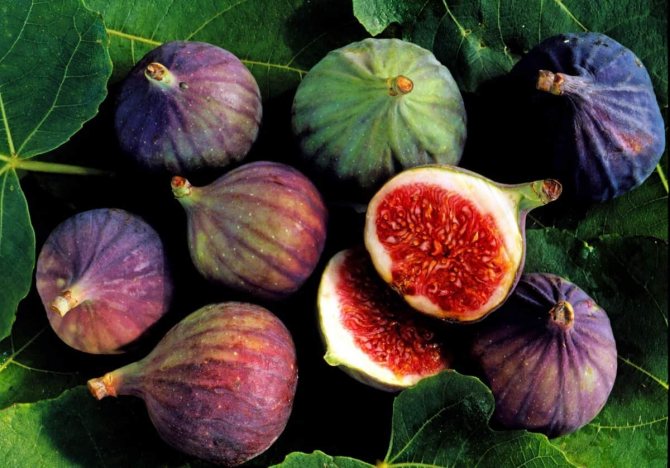

Soil for figs
If there is loamy soil on the site, a drainage layer must be formed without fail. It is made from fine gravel and sand.
To prepare the soil for planting a tree, you should mix the garden soil with compost, humus and manure, and then pour it into the planting pit. It is such a substrate that will be an ideal option for figs, allowing it to grow and develop correctly.
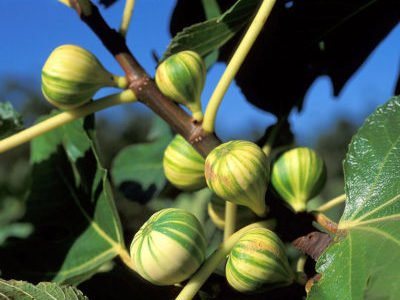

Landing
Fig is a fruit tree that can be planted in different ways:
- design of landing holes;
- digging trenches.
The method is chosen taking into account the layout of the personal plot.
Pit landing
First, you need to prepare planting holes with a depth and diameter of 1 m.A drainage layer 30 cm thick is laid on their bottom.To do this, use:
The walls of the pits are lined with pieces of concrete or broken bricks, stones, or other similar material. This will provide aeration of the soil, accumulate heat, and limit the growth of the root system.
The pit is partially filled with a ready-made substrate, then moistened, and when the moisture has been absorbed, a seedling is installed. The free space is covered with the remaining soil, compacted so that the root collar is on the surface of the earth. The plant is watered, the trunk circle is mulched with compost or humus with a layer of 10-15 cm.
Trench landing method
To plant a crop, you first need to prepare a trench. One seedling requires a trench:
- depth not less than 0.5 m;
- 60-70 cm wide;
- about 2 m long.
At the bottom, they dig holes 50 cm deep, fill them with a drainage layer 30 cm thick, fill them with prepared earth by half.
A support is installed nearby, after which a seedling is laid in a trench at an angle of 45 degrees. Its roots are covered with soil so that the root collar is on top of the ground, and the trunk is attached to the support. The soil is abundantly watered and mulched.
Competent landing solves many issues
The answer to the question of how to grow figs on the site, to protect them from frost, will be a smart planting. The following method is the most effective in our climatic conditions. Trees planted using this method practically do not suffer from frost even in the most severe winters. It should be noted right away that this is the most time-consuming operation of northern fig tree farming, but the return on it will be colossal. It's about landing in deep trenches.
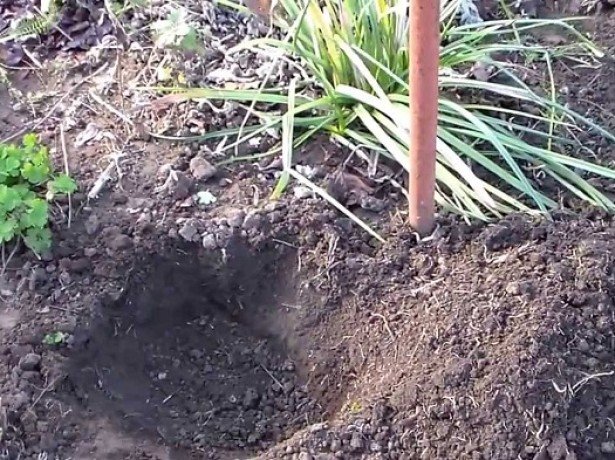

In the photo there is preparatory work for planting figs
First of all, let's decide on the landing site. It should be the sunniest in your area. It is desirable that from the south there are no strong trees or tall buildings, and from the other three sides there is protection from the same trees or buildings. This will create an additional hotter microclimate in summer - just what a fig tree needs. We will dig a trench not in the north-south direction, as for most other horticultural crops, but with a west-east orientation. This way we give the maximum amount of sun to our future fig grove.
Now we are digging a trench. You will have to work hard, because its depth is one and a half meters. We throw the top layer, the most fertile, to the south side, we will need it to mix the substrate in which we will plant the figs. Deep soil is usually poor, it is either sandstone or loam, depending on your area. We throw it to the north, forming an earthen rampart there.
The width of the trench is one meter. To the bottom, you can narrow it down to 60-80 cm. But only at the expense of the southern wall. North should be perpendicular. On the south side, we make a gentle slope towards the pit. This will allow better penetration of sunlight to the bottom of the bushes growing in the trench. So, we have an extended ditch, one and a half meters deep, a meter wide, with a gentle slope on the south side. If you have heavy loams, we pour drainage on the bottom: fine gravel or sand. Drainage is not required if you have sandstone.
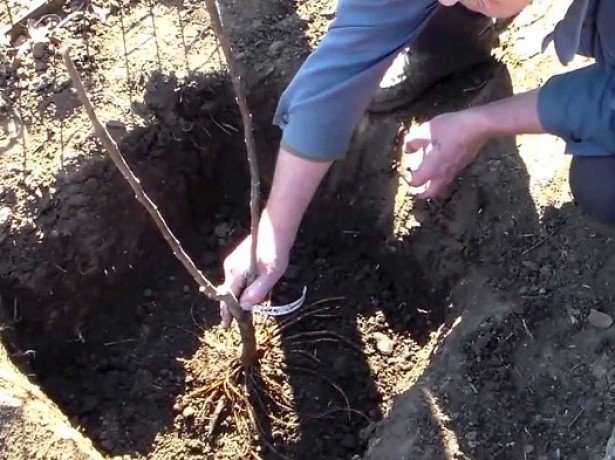

Photo of planting figs
We prepare the substrate for the planting pits. We mix the extracted surface soil with leaf or meadow humus, rotted manure, compost. We put all this into a hole so that its depth is reduced to 100-120 centimeters. With a step of two meters, we fill in earthen mounds, on top of which we install seedlings, spreading the roots evenly along the slopes of these hillocks. We fill them with earth from different sides, holding the trunks vertically, to a level just above the root collar - do not be afraid to deepen it, the soil will subsequently settle and open it.
We cover the southern slope to the pit with either a dense black film or boards. This is necessary to prevent the growth of weeds, which can block the bottom of the figs from the sun. From the north, we install a wall made of polymer, slate sheets or painted white boards. This prevents the soil from falling into the fig pit. Also, a light wall from the north will reflect the sun's rays, smoothing out the difference in the illumination of the bushes.
The most durable will be a wall made of bricks painted with lime.
The method of growing thermophilic horticultural crops near the southern walls is popular with northern European gardeners. During the day, the southern wall accumulates the heat of the sun, which creates a microclimate, as if moving your plants several hundred kilometers to the south.
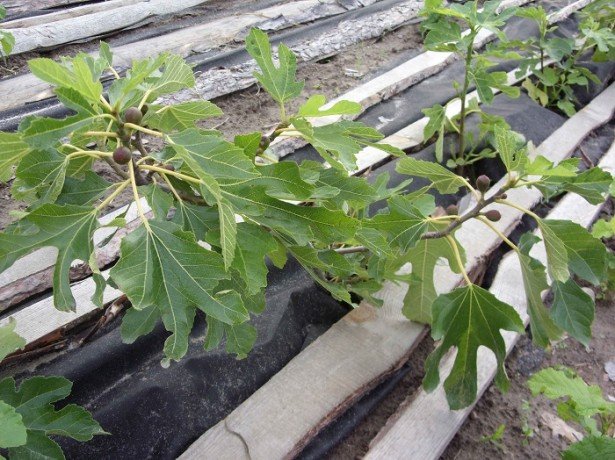

Photos of growing figs
We need such deep trenches so that with proper winter shelter from above, the figs will remain in the zone of non-freezing soil. After all, most of our soils freeze to a depth of about a meter. In this way, northern gardeners grow not only figs, but also pomegranates, laurel and even tangerines! All this winters well, gives yields, since the trench culture provides an almost subtropical microclimate.
Culture care
Caring for Figs in the open field is not difficult, the main thing is to complete all procedures on time. This will allow you to grow a strong, beautiful plant that will delight you with a tasty, abundant harvest for a long time.
Watering
Young seedlings need weekly watering, while 1 plant needs 7-10 liters of water. Subsequently, when the root system is fully formed, watering is reduced to 1 time in 10-15 days. To moisten the soil, use 10-12 liters of water.
In hot, dry summers, the frequency of irrigation can be increased without allowing the land to dry out. This can affect the quality of the fruit.
After each watering, the soil between the rows is carefully loosened, weeds are removed. For the period of formation of the ovary, the soil is not watered. The last time this is done only after the harvest.
Top dressing
The plant regularly needs high-quality feeding. Wherein:
- in the first decade of the growing season, nitrogen compositions are used;
- in the middle of the summer season, phosphate mixtures are in demand, thanks to which the ovary actively occurs;
- at the end of the growing season, the emphasis is on potash fertilizers, which will have a positive effect on the ripening of fruits and wood.
Also, every month you need to make compositions saturated with trace elements. Foliar dressing is applied twice a month by spraying. We must not forget about organic matter, which is important for fruit crops.
All fertilizers are applied only after watering, this will not burn the roots of the plant.
Pruning
The culture needs formative pruning. In order for its crown to have a compact shape, a trellis is built, to which a bush is tied. In the first year of growth, during pruning, 3 upper shoots with a length of 20 cm are left:
- one is allowed upright;
- the rest are tied to the trunk.
When the branches grow up to 1 m in length, they are bent parallel to the ground and tied for accurate angles. Subsequently, the stems grow vertically.
Next year, the trunk in the center of the bush is cut 20 cm above the place where the shoots appear. After that, carry out the same actions as last time.
This method allows you to form up to 4 tiers of branches, when at the end there are only 2 branches that go in different directions parallel to the ground. When their length reaches 10 cm, they are allowed upright.
This pruning allows you to create a compact, neat bush. It can become the center of the landscape composition along the garden path or elsewhere in the garden plot.
Also, once every 3-4 years, the plant is sanitized, during which root shoots and old, dry branches are removed. All cuts for any pruning are treated with garden pitch.
Wintering
The plant must be protected from winter cold. To do this, the trellis is removed, the entire ground part of the plant is bent to the ground.
A shelter with ventilation is being built, for this you can use sheet polystyrene foam or other material. The structure must be carefully secured to withstand even in strong winds. The shelter is removed no later than mid-April.
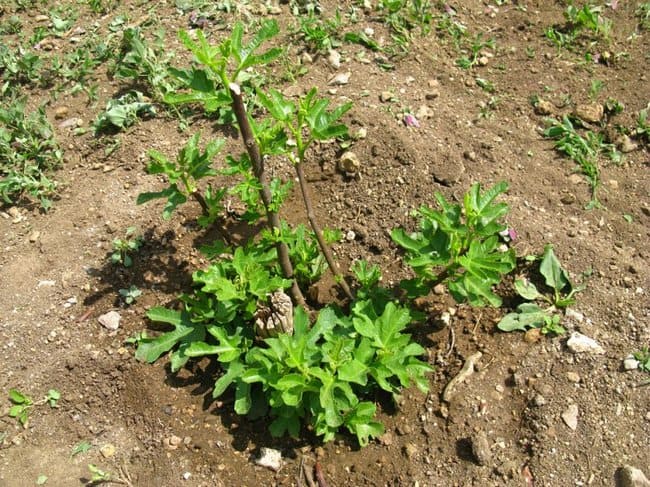

Shelter figs for the winter
With the arrival of the first frosts (but we are not in a hurry, light frosts only temper the plant), we bend the fig branches to the ground, and better and more reliably - we put in a dug trench in advance, when planting. We fix it with a wire to the hammered stakes and cover it with any more or less durable sheet material. Slate, plastic, chipboard, boards and even cardboard are suitable. And on top we fall asleep with a layer of earth 15-20 cm.
If you are going to use polyethylene film, keep in mind that in the event of thaws, the figs can blow out, and under dry shelters, mice will hibernate (and spoil the figs). For the convenience of shelter, it is worth removing perennial difficult bending branches, or leaving them uncovered. Maybe you're lucky and they won't freeze.
Diseases and pests
The culture is susceptible to pests, development of various diseases is possible. Most often, it can be detected:
- shoot cancer. Without timely therapy, the plant dies;
- gray rot;
- fusarium;
- anthracnose;
- souring.
To save a tree, it is necessary to carry out treatment with antifungal drugs until it is completely cured.
Among the pests that often attack Figs, the most common are:
- moth butterfly;
- beetle beetle;
- leafworm and leaf flies.
It is possible to deal with their appearance only through timely prevention, which is the treatment of the plant with special preparations. You can fix the problem with insecticides.
Transplanting figs
The success of the transplant will depend on how correctly it is performed. To transplant, you will need to dig a hole of the same size in which the figs were originally planted. It should be dug out very carefully so as not to damage the roots. The tree must be transferred to a new hole with an earthen lump.
The transplant should be carried out in the spring. If it is performed in the fall, then future cold weather will lead to kidney damage, which is highly undesirable. The tree should be moved to a sunny location, protected from wind and drafts. It is best to plant a fig tree between other trees or houses.
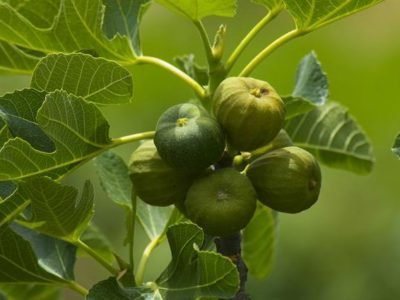

Planting and growing figs in the open field in Ukraine
Growing figs in the open field in Ukraine is possible not only in the south of the country, but also in Kharkov and Kiev regions. This unpretentious plant belongs to the genus of the mulberry ficus family. Grows in mountainous subtropical regions. It came to us from Asia Minor. In the Crimea and the Carpathians, it is grown in open ground, without shelter for the winter. Usually it is formed in the form of a bush, which reduces the likelihood of freezing of skeletal branches in harsh winters.
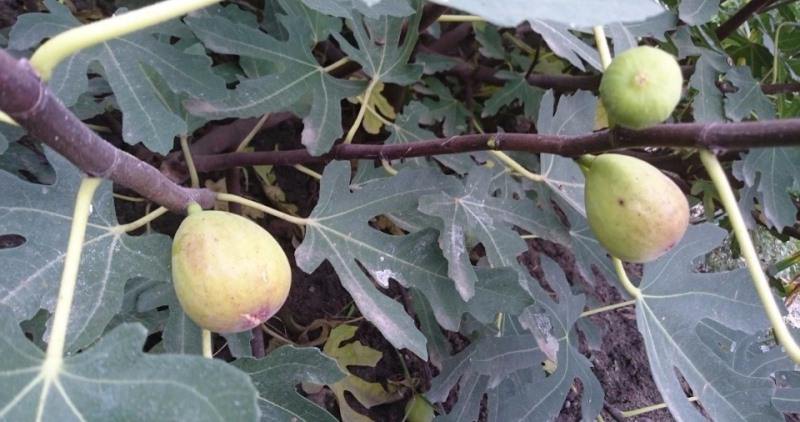

Growing figs in the open field in Ukraine is possible not only in the south of the country, but also in Kharkov and Kiev regions.
Growing in a greenhouse
Figs in a greenhouse can be planted in the ground, or they can be grown in the same wooden boxes. The only condition, besides protection from pests, feeding, timely watering, which should be indispensable, is the presence of sunlight throughout most of the daylight hours. The fig is grown in a standard or fan form, limiting the growth of roots so that it does not grow especially. For this purpose, it is necessary that when planting trees, the distance between them is at least 2.5 m.
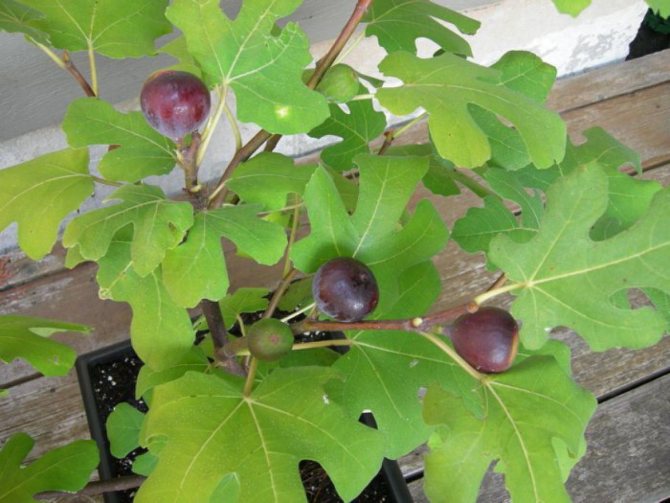

Growing figs is somewhat similar to cultivating peaches or grapes in a greenhouse, but figs in a greenhouse are best grown from Crimean varieties - Nikitsky, Dalmatsky, Crimean Black, Gift for the 50th anniversary of October. Despite the fact that there are more than 1000 varieties of subtropical ficus in the world, the hybrids of Crimean gardeners are distinguished by excellent yields and unique taste. They are highly resistant to temperature changes. In addition, they are self-fertile, because in the climatic conditions of the Crimea, there is no bacteriophage wasp that pollinates figs in the subtropics. In Crimea, varieties have been bred that simply have no equal in the world.
Planting a plant
Figs are planted in open ground in early spring, even before bud break. If a plant with a closed root system is planted, then this can be done in the second half of May, when the threat of spring frosts has passed. Such a plant grows almost immediately, so by autumn you can get a tree with a well-developed root system and several skeletal branches.
Depending on climatic conditions, different methods of planting figs in open ground are used.The northern regions are considered an area of risky cultivation of exotic plants, so it is advisable to place a bush in a hole for better shelter for the winter. In the Dnepropetrovsk region and to the south, they prefer to shape figs on a trellis, following the example of grapes - a four-arm cordon and with a shelter for wintering.
The landing pit is prepared in advance and has dimensions of 50x50 cm and 60 cm in depth. A bucket of humus and 200 g of superphosphate are introduced into it. The nutrient mixture is mixed, spread over the bottom of the pit and covered with earth. The walls of the pit are lined with slate or other material that limits the growth of roots. Then a seedling is installed, which is watered abundantly. After the water has been absorbed, the pit is filled with soil and compacted. During the growing season, figs require abundant watering, so it is advisable to mulch the trunk circle with humus or other material. This not only protects the soil from drying out, but also serves as an additional top dressing.
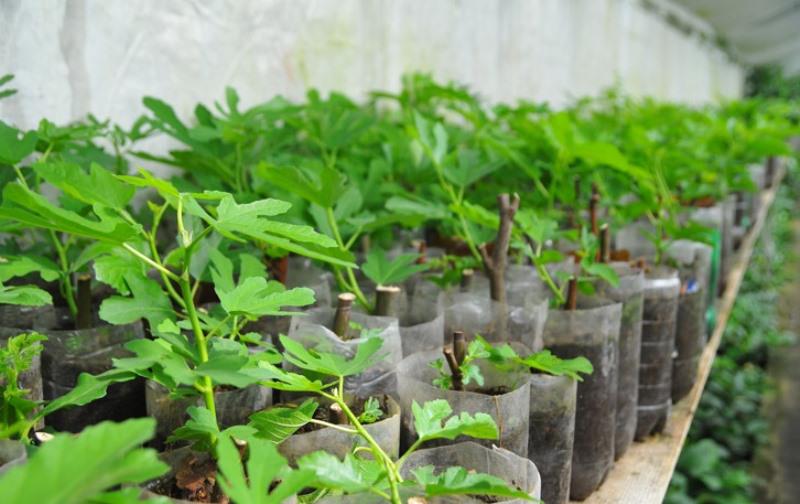

Depending on climatic conditions, different methods of planting figs in open ground are used.
Figs are planted in a sunny location, protected from winds and drafts. Periodic shading of the plant during daylight hours negatively affects fruiting. To protect against winds, protective screens are installed or plants capable of performing this function are planted.
To plant a mulberry tree in a pit, it is necessary to equip a deepening of sufficient size and prepare a place for the plant in it. Its size should provide a free location for the wintering bush. The depth of the pit is about a meter. Usually, 2 bushes are planted in one trench, and for wintering they are bent over and tied to each other. Boards are laid on top and covered with plastic wrap, on which a layer of leaves, dry grass or straw is poured at least 20 cm for better insulation.
Frozen branches recover very quickly and yield a harvest this year.
Storing fig cuttings before planting
And first, you should get cuttings of figs. It is not difficult to do this now, on the Internet there are many offers from amateur gardeners who offer a large assortment of varieties. It is only necessary to stock up on cuttings in the winter, or in early spring - before the beginning of the growing season.
A standard stalk is 10-25 cm long, as thick as a finger, with 3 to 4 buds. But this is the standard, but in practice all sorts of cuttings take root. Prepared cuttings of figs from the ends should be dipped in molten paraffin to reduce moisture evaporation, or you can do without this operation.
Next, the cuttings of figs are wiped with a weak (1:10) solution of hydrogen peroxide (disinfected), wrapped with a damp (not wet) cotton cloth and placed in a polyethylene bag. A tag is tied to the bag of cuttings with the name of the variety (if known) and the date. Placed in the vegetable compartment of the refrigerator (temperature + 4 ... + 5 degrees) and stored until spring. Periodically, once every two weeks, the cuttings are taken out and examined. If mold appears, then wipe it with diluted peroxide, and if the fabric is dry, it is slightly moistened.
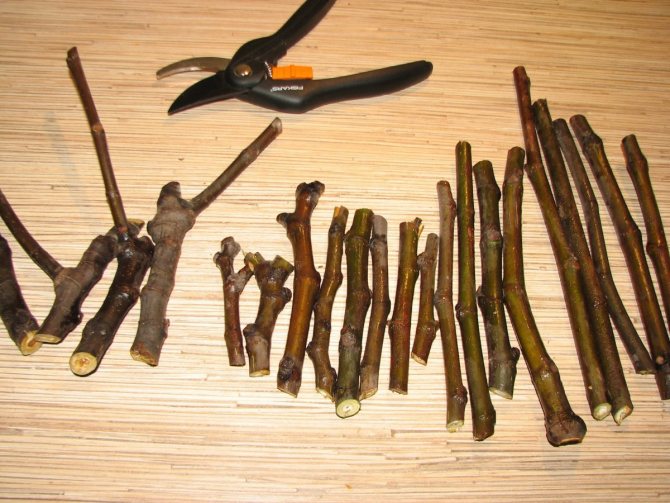

Fig cuttings are ready for rooting. <игорь>
Bush care
Fig is a deciduous, unpretentious plant that tolerates drought well. When grown outdoors, it easily tolerates frosts down to -20 ° C. It does not require special care. However, this does not mean that you can plant a plant and forget about it. Caring for a fig when growing it in the open field involves proper planting, regular watering and feeding, crown formation and shelter for the winter.
The first 2 years, the seedling can not be fed, since it will have enough nutrients introduced during planting. Starting from the third year, nitrogen and potash fertilizers are added to the trunk circle.From the second half of summer, nitrogen feeding is stopped, since it causes an active growth of green mass and new shoots, which will not have time to ripen before the cold weather and will freeze in winter. Potassium has a beneficial effect on the development of the root system, which has a positive effect on the winter hardiness of the plant, as well as on the laying of fruit buds of the next year's harvest.
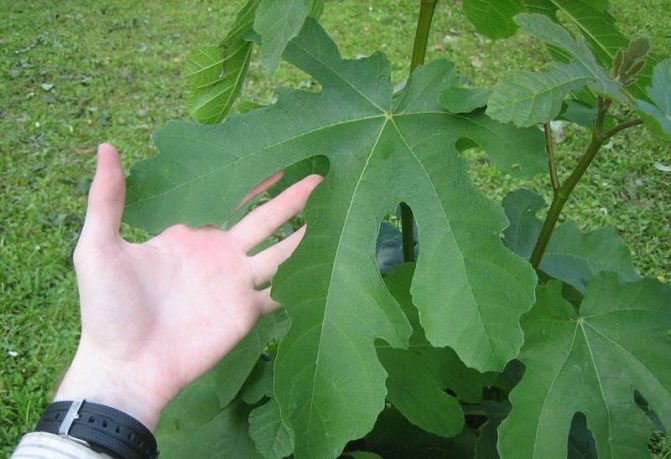

Fig is a deciduous, unpretentious plant that tolerates drought well
Regular, abundant watering of both the seedling and the adult bush makes it easier to tolerate the heat. With a lack of moisture, the leaves become lethargic, turn yellow and fall off, and the fruit ovaries do not develop and wither on the branches. In Ukraine with its temperate climate, 30-40 liters of water must be poured under each plant for 1 watering. Since the root system of the figs is located at the very surface (in the aerated soil layer), it is necessary to mulch the trunks. This will provide oxygen access to the roots and prevent loosening of the soil. Hay, peat, sawdust of trees that do not contain resin, compost are usually used to cover the soil under the plant. The mulch layer should be at least 5 cm.
During the ripening period of the crop, the amount of introduced moisture is reduced or irrigation is stopped altogether. Watering in the fall provokes the growth of young shoots, so they are not carried out at all. The plant will have enough atmospheric moisture. Figs are not susceptible to fungal or other diseases, so there is no need to use chemicals. Overripe fruits attract wasps, which can damage ripe ones. To do this, they must be periodically collected, avoiding cracking.
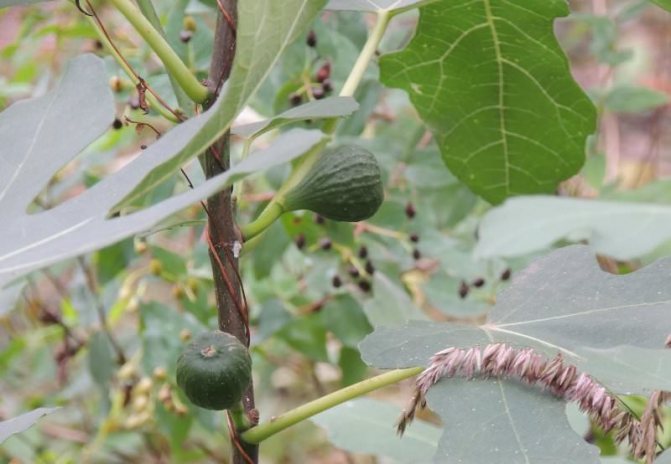

During the ripening period of the crop, the amount of introduced moisture is reduced or irrigation is stopped altogether
The crown begins to form from the second year. Growing plants that are sheltered for the winter in open ground does not imply that they have a high stem. It is enough that it is no higher than 30-40 cm, and when it is formed on a trellis - 10-15 cm. In late autumn (but before the onset of the first frost), thick old branches are cut out from the bushes, leaving several well-developed shoots of this year. The harvest of the next year will be formed on them.
Rooting fig cuttings
In early spring, fig cuttings can be rooted. Freshen the bottom cut with a sharp knife and make a few shallow scratches at the bottom by cutting the bark. For good rooting, it is worth holding the cuttings for the time set according to the instructions in a solution of any rooting agent. Although many varieties take root easily without it.
Now we place the cuttings of figs in some breathable and moisture-absorbing substrate. Someone uses calcined sand, while I use either sphagnum moss or, as this season, coconut substrate. The main thing is that it is not wet, and water does not flow from it, it must be exactly wet.
Any container can be used as a container, but with holes made for air exchange: a plastic container with a lid, a plastic bag, two plastic cups, a container with a glass jar, etc. The temperature for fig rooting is + 22 ... + 25 degrees.
After about a month (or maybe even earlier), the first small roots appear. While they are small, the cutting should be planted in a container with a loose and nutritious mixture. Overgrown roots break easily and the plant again spends time and energy on growing new ones, so do not delay.
Planting mix? Peat or coconut substrate plus garden soil. Fig cuttings grow for about a month, and then, when the threat of spring frosts has passed (around May), after hardening, they can be planted in a permanent place.
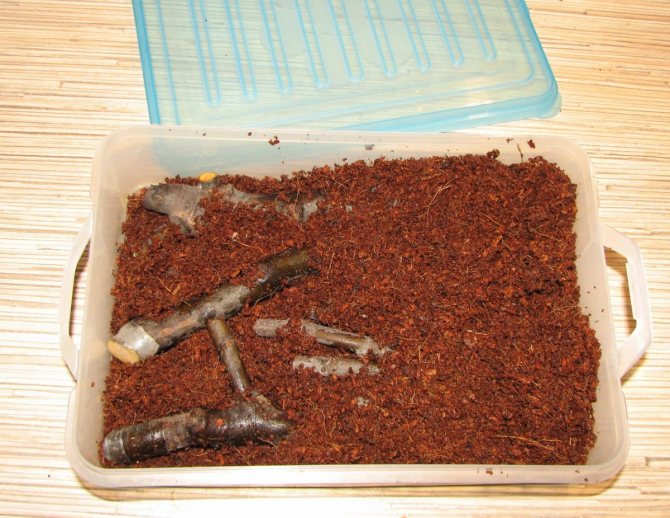

We place the cuttings of figs in any breathable and moisture-absorbing substrate. <игорь>
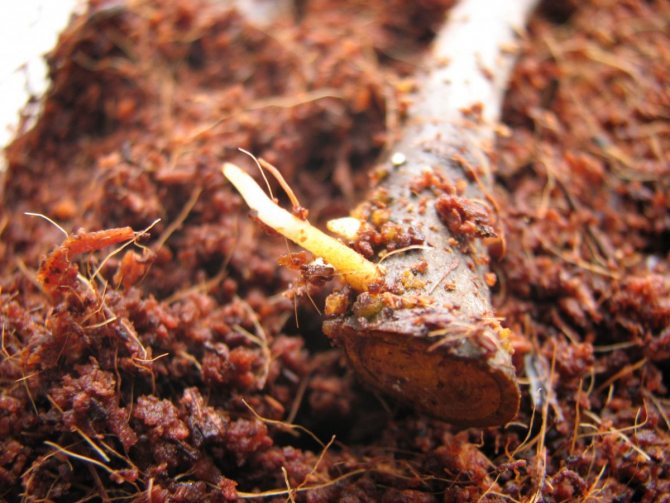

After about a month, the first small roots appear. <игорь>
Indoor fig
Many lovers of exotic plants, if it is impossible to grow them in the open field, successfully grow a tree in indoor conditions.Fig is a light-loving plant, so the best place to find it would be a window facing south or southeast. In winter, it can be placed on a glazed balcony or in a room where the temperature does not drop below 5-7 ° C.
In the first 3 years, the plant is replanted every year. After 3 years - 1 time in 3 years. This procedure is carried out in January or February, even before the beginning of the swelling of the kidneys. To do this, use a flower pot with a diameter of 2-3 cm larger than the previous one. Transfer of plants is carried out with a lump of earth. At the bottom of the pot, drainage must be arranged.
Indoor figs develop more slowly than those growing in the open field, but they can begin to bear fruit in 2-3 years. If there are no fruits during this period, then the plant most likely lacks sun or moisture. Top dressing of figs is carried out during the growing season 1-2 times a month. To do this, use either a nitroammophoska at the rate of 5 g per 1 liter of water, or a complex fertilizer, according to the instructions.
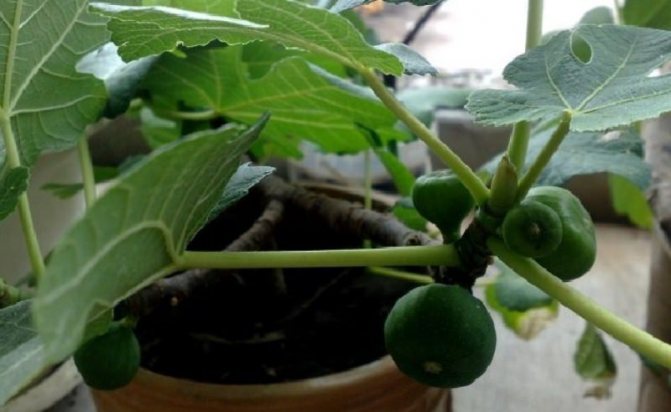

Many lovers of exotic plants, if it is impossible to grow them in the open field, successfully grow a tree in indoor conditions.
At 6-7 years old, the plant is usually transplanted into a large container (tub) and installed in a permanent place. In indoor conditions, figs grow rapidly, therefore crown formation is one of the main conditions for abundant fruiting. Pinch young shoots over 4-5 leaves. During the growing season, branches are not cut out, since the development of the root system depends on the amount of green mass, and therefore the nutrition of the entire plant. Indoor figs bear fruit once a year and depends on the conditions of detention.
The fruits are used for food not only as a delicacy, but also for medicinal purposes - for colds and vitamin deficiencies. Due to the high sugar content, it is not recommended for people with diabetes mellitus. Figs are eaten fresh, dried and dried, and jam is made from it. It is one of the most delicious dried fruits.
Where to plant
When choosing a planting site, it is necessary to consider where the figs grow in their origin. This warm-loving fruit prefers a lot of sun and light.
Thus, an important factor for a successful planting is the condition that the total temperature indicator during the growing season should be 400 degrees. This is the most important rule for a good and consistent harvest.


The most optimal place for planting is the southern side of the site, so that there are no tall plants, heaps and buildings. On the other three sides, small shrubs or structures that protect from the winds are allowed. The planting side should always be open and sunny.
Features of care at different times of the year
A new vegetation cycle for figs begins during the spring release from the winter shelter. It is important to do this in a timely manner, because with the onset of heat under the shelter, the plant very quickly grows out and dies. It is better to pour hot water on the soil around the figs that has not yet thawed and make a greenhouse that protects the tree from day and night temperature fluctuations than it will "burn" under already unnecessary shelter. Crown formation, pruning is also a spring concern of the gardener. In summer, care comes down to pinching shoots, watering, feeding and harvesting.
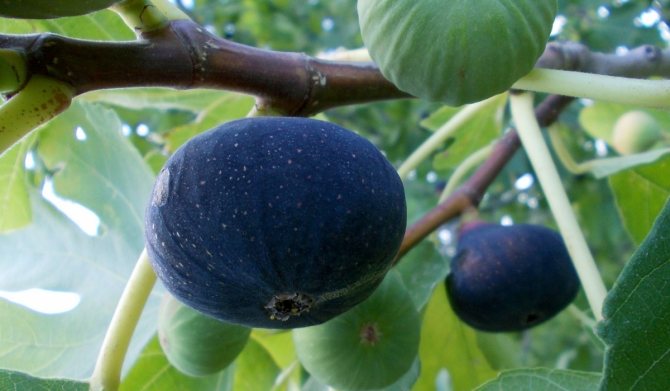

In the fall, having built a greenhouse, you can ensure the ripening of all fruits remaining on the branches. And a month after the end of fruiting, carry out the last watering, forming and sanitary pruning. Good pruning in the fall is a must. All dry and damaged shoots are cut to the ground, without stumps, the shoots are shortened - it is easier to hide a lightweight crown in a winter shelter.
Preparing for winter
Fig, even in the southern regions of Russia - Krasnodar Territory and Stavropol Territory - requires mandatory shelter for the winter. It is easier to cover the trench figs as they are already in the recess. For this, the branches are bent to the ground, fixed, covered with foliage.The trench is covered with polystyrene, boards, sheet plywood, covered with a film on top and the entire system is completely covered with at least 10 cm of earth. Low standard and bush fig trees are tied, wrapped in several layers with covering material or burlap. The base is covered with earth on all sides, covered with spruce branches.
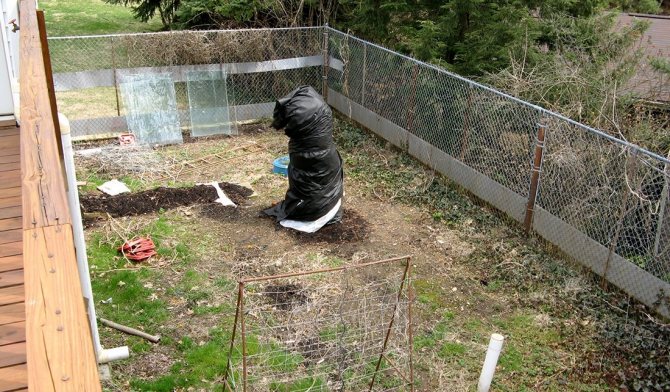

Photo: <>
Pests
The following pests can attack the shrub:
- A fire butterfly, which can lead to rotting of the fruit.
- The leafworm, which is considered a pest of honeysuckle, damages the bush in such a way that the leaves turn yellow, the fruits begin to rot, and the stem itself dries out.
- Listobloshka threatens to slow down the growth of the stem due to the lack of nutrients sucked out by the pest.
- The bark beetle damages the bark, which often leads to the death of the plant.
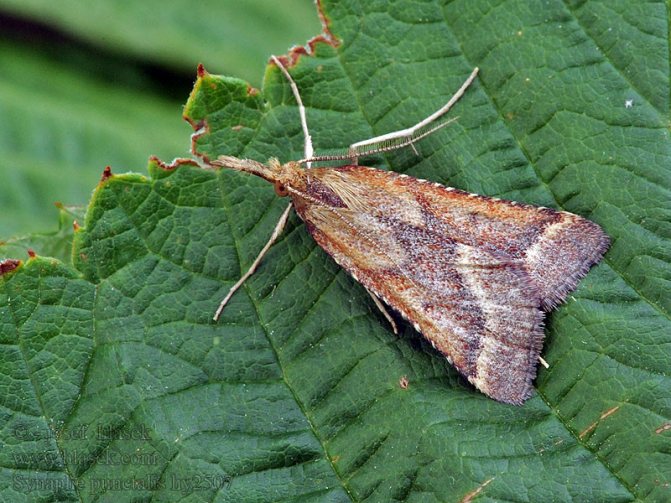

The fire butterfly can lead to fruit rot
To combat pests, it is necessary to use special insecticides, and various fungal diseases can be overcome by normalizing the climatic irrigation regime and careful care.
Preliminary activities
Figs, cultivation at home of which is practically no different from cultivation on the street in the southern regions, will develop well in the future, of course, only if the planting material is properly prepared.
You can take fig seeds only from well-ripened largest fruits. They should be removed along with the pulp. Next, the planting material must be put in a sieve and carefully rinsed with running cold water. The seeds freed in this way from the pulp should be dried on a cotton napkin. They can be sown in a day.
Figs in winter
A couple of bags with needles or sawdust also helped, which are used as follows: during the first autumn frosts, you need to pour a few bags of sawdust on the bushes ... and that's enough. The branches above the sawdust freeze and deteriorate, but under them they do not. In the springtime, the frozen branches are cut off, and the spilled sawdust is left (insurance in case of unexpected frosts in the spring). Then new shoots sprout from them, and the plant begins to bloom. Branches without fruit are automatically removed. In July, you need to pinch the twigs with berries. Therefore, the fruits have the ability to absorb more juices and ripen.
Opening figs after winter
The figs need to be opened in mid-April so that the stems of the plant do not start to rot. If the soil under the shelter has not yet thawed, it can be poured over with hot water.
When the plant is freed from shelter, a greenhouse should be erected over it and branches should be spread. Then clean the stem of dry foliage, but the fruits that have formed over the winter must be left on the branches.
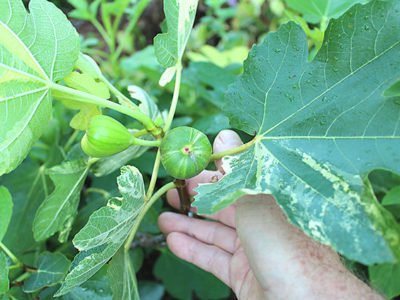

Medicinal properties of figs
In folk medicine, the fruits and leaves of figs have been used since ancient times. Means made on their basis allow you to fight the following ailments:
- Bronchitis and pneumonia;
- Thrombosis and thrombophlebitis;
- Angina and laryngitis;
- Constipation;
- Depression;
- Inflammatory ailments of the genitourinary system;
- Hypertension and anemia.
Effective wound-healing ointments are prepared from dried figs. Decoctions from the leaves are used for eczema and furunculosis. The phytotherapeutic drug "Psoberan" is prescribed for the treatment of vitiligo and psoriasis.
Figs with cough milk recipe
As mentioned above, figs can cope with many diseases, including cough, for which there is one effective remedy based on this sweet fruit.
To prepare a medicinal drink, you should boil half a liter of milk over low heat. When it boils, you need to put 5 fruits of dry figs in it, after which the resulting mixture should be boiled for about half an hour. Then you need to remove the pan from the heat, wrap it in a towel and leave to infuse for 4 hours.
Milk and figs should be consumed separately.Fruit should be eaten three times a day before meals, and milk should be heated and drunk before going to bed. Milk-fig therapy is carried out throughout the week.


Open ground varieties
The main criteria for choosing a variety are frost resistance, ripening time, yield, size and taste of the fruit.
The farther north the growing region, the more important it is to choose self-fertile varieties, since in cold latitudes there are no insects that can pollinate figs.
Among the self-fertile varieties of figs, the following are more popular:
- “White adriatic” with yellow-green fruits at the stage of full maturity, the flesh of which is pink;
- "Dalmatian" ("Dalmatika") - cold-resistant figs with pear-shaped gray-green fruits, sweet and sour in taste;
- "Kadota" - berries with pear-shaped fruits, sweet, cold-resistant variety;
- "Brunswick" - long-fruited;
- "Tiger" - striped fruits with a sweet berry taste;
- "Turkish" - frost-resistant.
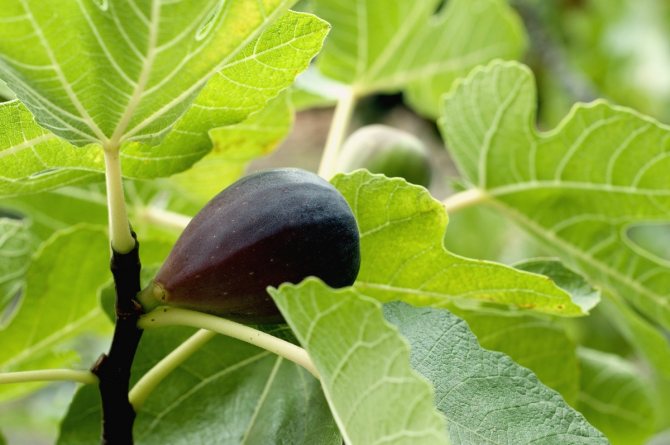

Photo:
Of course, growing figs in unusual conditions is a laborious process that requires patience and strength. But if we put aside doubts about success and uncertainty in their capabilities, then eating a fig tree fruit grown with our own hands is a completely doable task.
Top dressing of figs
Fertilize the tree at least twice a month. At the beginning of the growing season, it is necessary to use nitrogen fertilizers. Closer to the middle of summer, phosphates will be required, as they contribute to fruit setting. At the end of the growing season, potash fertilizers should be applied. They will allow the figs to ripen better and faster.
Every month the tree needs to be fed with microelements, fertilizers that help it to develop normally. Root dressing should be done outside the root twice a month by spraying the figs with a nutrient solution.
For the fig tree, organic feeding is also important, in the form of humic acid, microorganisms and soil. Top dressing should be carried out only after watering, so that there are no root burns.
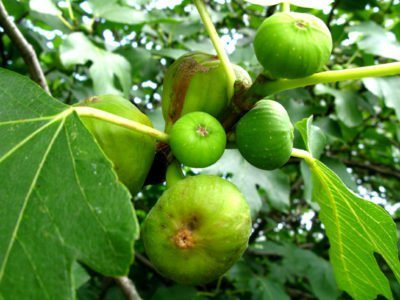

Harvesting
When the fruits are filled with the color characteristic of the variety, become soft, and drops of nectar appear on the skin, it is time for harvesting. Another sign of ripeness is the lack of juice when separating the fruit from the shoot. Since the ripening of figs is an uneven process, the fruits are removed gradually as they ripen.
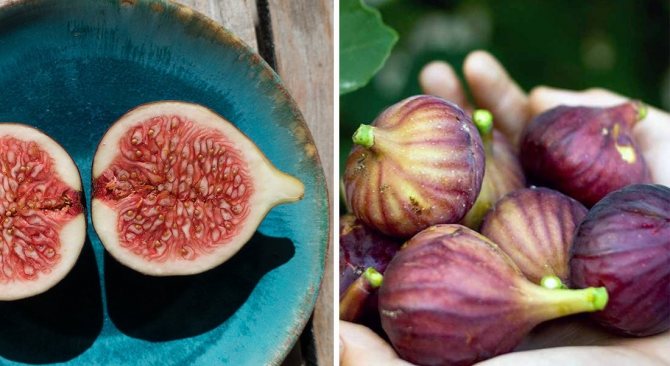

Photo: collage <>
Why figs don't bear fruit
- Little light - put on the lightest windowsill or transplant to an open, sunny place in the garden.
- Too much root space - transplant into a cramped pot or limit the space in the planting pit.
- Frozen crown in winter - it takes up to 3 months to recover.
- Little water and power - Water abundantly and feed regularly.
- Pest infestation - spray with Epin solution or an analogue 2 times.
- Dense crown - cut off the extra branches. Figs give the best yields when grown in 2 stems with regular pinching of the tips.
So, caring for figs is not at all difficult, and you can feast on the harvest of exotic plants in any climate.
Did you like the article? Support our project by reposting on social networks!
Fig Cooking Recipes
In addition to medicinal properties, figs have an unusual honey taste, thanks to which they are used to prepare many culinary delights. Below you can find out how to prepare the most delicious dishes and drinks based on it.
Fig jam
Fig jam is not only tasty, but also healthy, and you can cook it in just 40 minutes.
Jam ingredients:
- Granulated sugar - 0.5 kilograms.
- Fresh figs - 700 grams.
Cooking method:
We take a ripe fig, wash it and cut off the ends. We put the fruits in a saucepan and cover them with sugar. We leave the mixture for three hours until the juice appears.
We put the saucepan with fruits on low heat, bring to a boil and remove the foam.Boil the figs for 5 minutes, stirring occasionally to dissolve the sugar. After that, the jam should be removed from the stove and left to infuse for 10 hours.
After the time has elapsed, you need to boil the jam over low heat again, collect the foam and boil for 5 minutes. Then the pan must be removed from the heat again and the jam should be left for 10 hours. This procedure should be repeated once more, after which the jam must be poured into sterilized jars and rolled up.
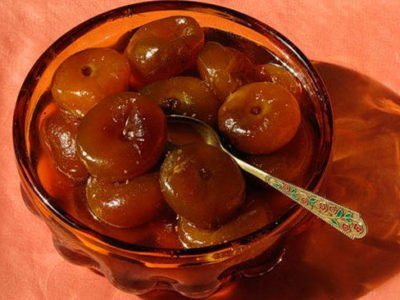

Fig cake
This easy-to-make fig and mascarpone cake is a great decoration for any occasion.
Components of the filling:
- Yogurt - 600 grams.
- Granulated sugar - 100 grams.
- Mascarpone - 300 grams.
- Gelatin - 20 grams.
Components of the cakes:
- Baked muesli with nuts - 400 grams.
- Butter - 120 grams.
Decoration:
- Lemon juice - 0.5 lemon.
- Fresh figs - 20 pieces.
- Sugar - 50 grams.
- Raspberries - 120 grams.
Cake preparation:
We take a detachable form with a diameter of 24 centimeters, put cling film on the bottom, and cover the sides with parchment. Cooking the cake. To do this, we heat the butter, and grind the muesli in a blender. Then we combine these two ingredients and put them in a mold and level them, tamping them in parallel with a spoon. Put the finished cake in the refrigerator for half an hour.
We take gelatin and soak it in water for 10 minutes. Place the finished mixture in a saucepan and heat it over low heat until dissolved. Remove from heat and filter into a container with yogurt. Add cottage cheese and mascarpone, and then whisk. Pour the resulting filling onto the cake, level it and put it in the refrigerator for 4 hours.
We take raspberries and sugar, mix and put in a saucepan. We put on the stove and bring to a boil, then boil for 3 minutes and refrigerate. When the mixture has cooled, mix it with lemon juice and grind with a blender. Rub the resulting sauce through a sieve.
After 4 hours, take the cake out of the refrigerator, take it out of the mold and decorate it with sliced figs and raspberry sauce.


Preparing figs for winter
After the growing season is over, you can begin to prepare the plant for winter. For this purpose, you should remove the trellis and bend the shoots to the ground. On top of the bush, you need to lay wood or a sheet of plywood, and put a film on top.
Then cover the resulting structure with earth by 10 centimeters. Thus, the root system will not be affected by frost. If the frosts in the region where the figs grow are strong, then an additional insulating layer of straw, leaves or spruce branches should be put. If the oilcloth is too dense, then holes should be made in it for aeration.
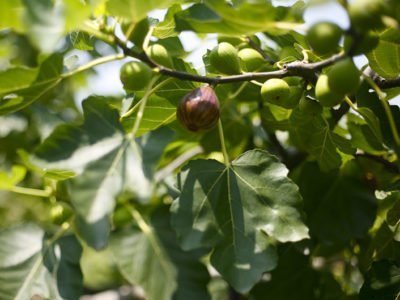

Transplanting a young plant
For the first few years, the fig is transplanted annually after the plant leaves the dormant period, but before the leaves open. Young seedlings develop quite quickly and need a larger pot. After the seventh year of life, figs do not require such a frequent change of the pot - a transplant can be carried out every two to three years or if clearly necessary.
An adult fig tree is transplanted into a container only 5 cm larger in diameter than the previous one, otherwise the roots will actively grow, and fertility will decrease.
In order to transplant the figs, the pot must be doused with boiling water, and at least 3 cm of drainage should be placed on its bottom (you can use pieces of foam). Drainage is extremely necessary for a plant of any age, it will allow the roots to breathe, eliminating stagnant water and rotting of the root system.
Culture transplant
To plant figs in a pot, you must:
- Mix all parts of the soil substrate and decontaminate the soil.
- Lay expanded clay and cover with prepared soil, put a layer of clean river sand on top.
- Transfer the seedling from the container, slightly compacting the soil.
- Water the young plant gently.
- Place the pot in a bright place.
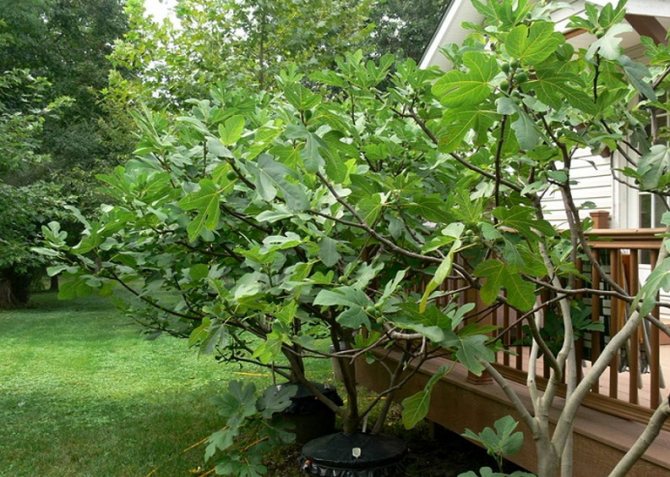

Figs, planted from a cuttings or layering, will delight the first fruits for 2-3 years. It is quite easy to grow figs in an apartment. With a little effort and providing proper care, the tree will delight you with tasty and healthy fruits.
Home cultivars
Before planting, you need to decide on a variety that can grow successfully. As a rule, it is recommended to choose a self-fertile undersized species. There are three main types of pollination:
- mixed (does not need pollination in spring, only in autumn);
- parthenocarpic (seed development independently);
- a variety that requires pollination.
The most common and suitable are the following types:
- Purple Sukhumi;
- Kadota;
- Sochi No. 7;
- Solar.
You can try to grow the Crimean Black Fig, but it is more suitable for the garden area.
Pollination of figs
In old sources, figs are described as a bee-pollinated plant, blooming in a berry, which at the end of the fruit has small holes where a special "bee" can penetrate. The fig wasp does not live on the Ukrainian lands, and we could finish the article at this place if some specialists had not produced new varieties of self-pollinated plants. The original fig, which is pollinated by the fig wasp, is quite rare.
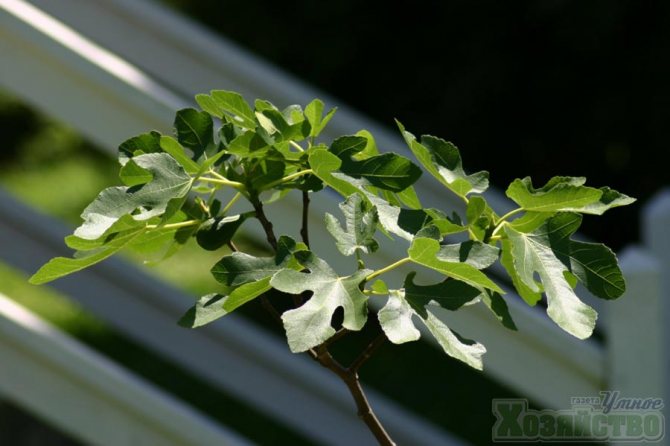

Fig tree
It is interesting
In the biblical story, some inconsistencies are noticed: the first people (Adam and Eve) ate the apple fruit forbidden by God, and covered their naked body with fig leaves. Most historians assume that the fruit and leaves were part of the same plant - the fig tree. It was reasonable to include the apple in the Bible, since the fig is a plant from the southern countries, and the population of the northern lands practically did not know about the fig tree.
Where in Russia can you grow figs?
It seems impossible, but it is quite possible to cultivate a subtropical culture in our northern climate and despite the severe winter frosts, it will bring a good harvest. This requires only the right agricultural technology.
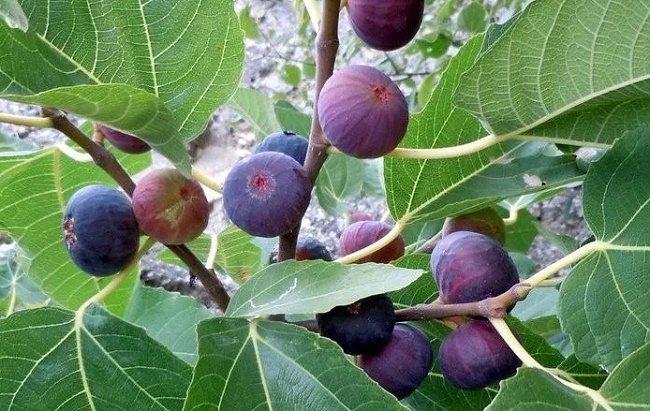

Where figs grow in the wild, at an average daily temperature of + 10 ° C for the entire growing season, the sum of temperatures reaches + 4000 ° C. With such indicators, the harvest will be plentiful and stable. Therefore, when cultivating a crop on your own, it is important to ensure the same conditions using the trench method.
Under certain conditions, with the obligatory shelter for the winter, it is possible to plant a fig tree in central Russia. Although in the Caucasus and Crimea, it is found in the wild. In the Krasnodar Territory, in October-November, fig trees require special greenhouse conditions to survive the winter.
In regions with a harsh continental climate, the culture is bred in winter gardens and greenhouses. Figs bloom for 2-3 years after planting. It brings a high yield from 7-9 years old. The culture is propagated by seeds, cuttings and layering.
How to choose a place for figs in the garden?
To understand how harmoniously this tree will be combined with other plants on your site, first look at the photo of an adult fig.
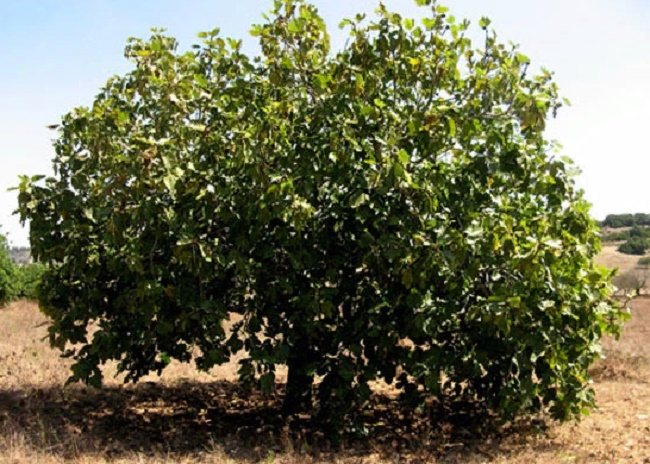

When choosing a specific planting site for a given crop, consider the following requirements:
- Well-lit space.
- Lack of blown winds.
- It is desirable to have a south side relative to the house in order to provide the most comfortable conditions for the development of figs in terms of the amount of solar heat.
- The depth of the groundwater is no more than 2.5-3 meters.
- The flat surface of the site or a gentle hill.
Important! Areas located in places where cold air accumulates - lowlands, river floodplains, gullies are categorically unsuitable for growing figs.
Planting dates for figs
Considering that figs are very fond of warmth, then it is necessary to plant it only in the spring, so that it has time to properly take root before the first cold weather, otherwise the plant will die. Experienced gardeners identify the exact timing of planting, namely March 15-30, immediately after the start of warming and melting snow.
Purchase of planting material
When buying fig seedlings, it is best to choose two-year-old specimens with a pair of side shoots. The older the seedling, the more difficult it is for it to take root, the adaptation period is much longer. Saplings with damaged roots or shoot bark should be discarded. There should be several buds on the shoots.
Reproduction methods
Propagation by cuttings... To obtain seedlings of this exotic fruit plant, you can use:
- green cuttings;
- lignified cuttings.
The green cuttings are cut immediately before planting from a suitable adult, fruiting plant. They should be used as ripe lower branches, on which there are at least 3 - 4 buds.
The length of the cuttings should be from 10 to 15 cm, the upper incision is made straight, and the lower one - at an angle, and several shallow longitudinal grooves are cut above it - this will help the roots to form faster. After cutting, the cuttings are slightly dried until their milky juice hardens, and then placed in a heteroauxin solution for 12 hours.
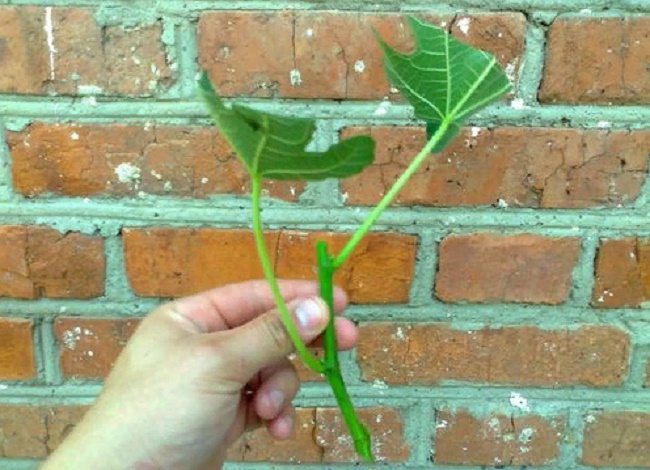

At the same time, an earthen mixture is being prepared, in which the cuttings will be planted. It goes through a steaming procedure for disinfection to eliminate the risk of rotting or mold formation. After that, you can proceed to planting cuttings. This is done as follows:
- Their ends, where roots should form, are dipped in ash, set in paper cups and sprinkled with a prepared earthen mixture.
- The planted cuttings are covered with foil, periodically watered and sprayed.
- After the buds begin to grow on them, the cuttings will need to be taught to live without shelter.
The optimum air temperature in the room where green cuttings of figs are grown will be +22 degrees. If everything was done correctly, after about a month they will have a root system, and the resulting seedlings can be planted in the ground.
Unfortunately, fruit-bearing figs do not always have the opportunity to cut a green stalk. Therefore, in order to grow a fig tree in their own garden, they use lignified cuttings. They are harvested in late autumn and sent for storage until spring. You can store them either in wet sand in a warm cellar, or simply dig them into the ground, after wrapping them with a cloth and covering the tubercle with a film to avoid excess moisture getting into them.
Seed propagation... A more difficult and time-consuming way to reproduce a fig is to grow its tree from seeds. This planting material is taken from ripe fruits. They should be thoroughly rinsed with water and dried within 24 hours.
In the prepared soil, seeds are planted in early spring to a depth of no more than 3 cm and carefully watered from a sprayer. Before the first shoots appear, the container with the seeds planted in the ground should be covered with polyethylene. And when the first shoots appear on the surface of the earth, the polyethylene will need to be periodically opened in order to give young plants the opportunity to breathe and get used to the environment.
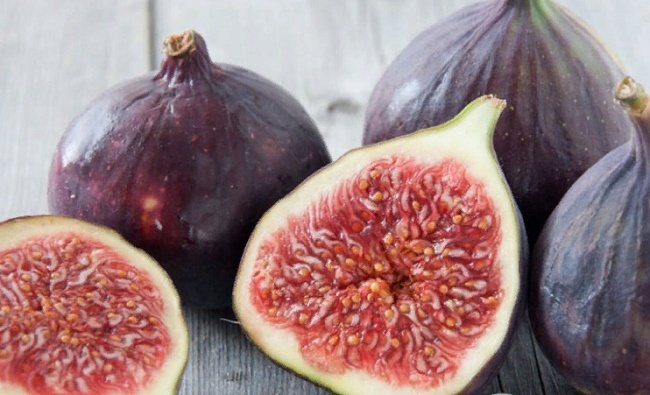

After the sprouts are well grown, they are transplanted into paper cups. There they continue to grow and develop, and around the beginning of May, they can be transplanted into open ground, first under a film, to enable them to adapt to a new place. It will be possible to transplant figs from seeds to a permanent place in about 2 years. By this time, a strong and healthy seedling should already have formed.
Figs reproduce rather quickly by root shoots, which are abundant in low-growing varieties. It is enough just to carefully dig out the root, separate part of it and transplant it to a previously prepared place. You can also use young shoots, the so-called - layering. Bend the selected shoot, cover with soil and water. And after the root system is formed, dig it up and transplant it to a permanent place.
Where and how to plant
Figs, which are easy to grow and care for at home, usually develop well and give good yields even indoors. However, this is possible, of course, only if it is properly planted.
Sowing figs should be in prepared boxes. The latter should be of sufficient height. A drainage layer of expanded clay or pebbles is laid at the bottom of the boxes. Next, the soil mixture is poured. Figs are absolutely undemanding to the ground. You can just use a regular mixture of garden soil, humus and well-rotted manure to germinate seeds.
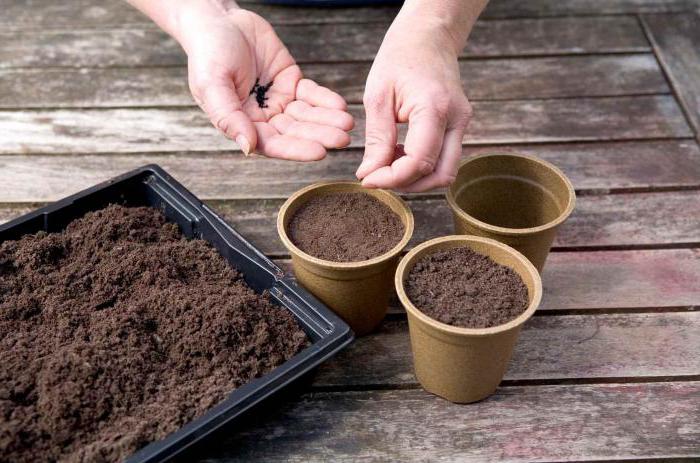

Figs growing from seeds at home
You can also propagate a fig tree using seeds. The seeds are taken from ripe, juicy fruits. To get them, you need pulp. It must be removed and placed in a warm place for five days. When the mass is fermented, the seeds should be separated from the pulp, washed and dried. The finished material must be stored until February, and then planted in the soil.
Seeds should be planted in a substrate based on sand, humus and turf, in holes 0.5 centimeters deep. The first shoots will appear in a month if the soil is sprayed with warm water every day. After the appearance of the first 6 petals, the seedlings must be transferred to separate pots with a diameter of 10 centimeters or more.
For planting in garden soil, the plants will be ready after two years. Throughout this time, the seedlings need to be fed and, with the onset of heat, taken out into the street, where they should be until the onset of autumn.
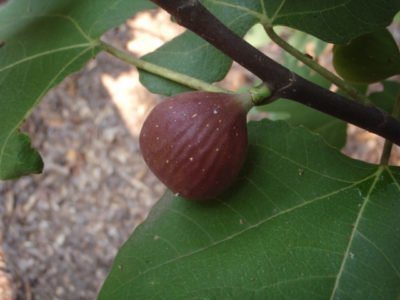

Pruning and shaping the crown
Particular attention should be paid to pruning when caring for figs. In the southern regions, pruning is performed 2 times a year - in autumn and spring. Depending on the shape of the fig bush, a crown is formed. On bush-shaped figs, for the first two years, a couple of main branches with a stem length of about 40 cm are left.
The formation of the crown of a standard tree is carried out from 3-4 main branches, but the length of the stem should be within 60 cm. The places of the cuts must be covered with garden varnish in order to prevent the ingress and spread of infection.
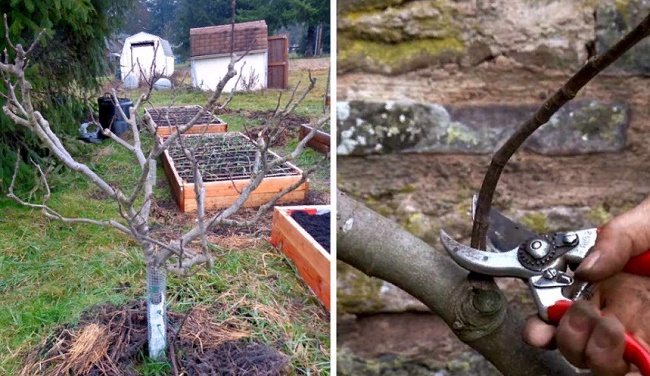

Formative pruning is carried out in the first year. From a young tree, you need to select the main strong branch, and cut the rest to the base. After a year, cut the branch, located at a height of about 1.3 meters, to the bud. The result will be a half-stem shape, and skeletal branches will form in the spring. In the third year, the branches are shortened by half, facing outward.
In the future, after the formation of the skeleton of the tree, pruning is not required, with the exception of unsuccessfully growing branches. In summer, it is recommended to pinch the growths, this will avoid the growth of the tree in height. For the winter, the fruit plant is insulated or covered with earth.
Reproduction
Figs, the care and cultivation of which require care, are also demanding on the methods of reproduction. It is believed that the best ways to transplant a plant in our climate are:
- reproduction using cuttings;
- seed method.
Propagation using cuttings Seed method
Possible problems and solutions
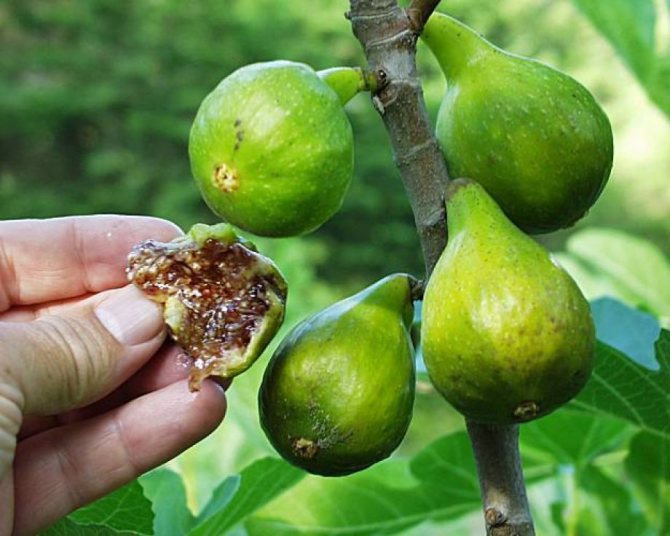

With proper care, figs will delight with an abundant tasty harvest.
Figs, with proper care, are rarely exposed to pests. But you need to pay attention to the formation of the crown. With the intensive development of culture, it grows at a rapid pace. Long shoots must be removed in a timely manner. This will strengthen the lower branches.
The root system of figs can suffer from a lack of air. Regular loosening of the soil will help to avoid this. With insufficient moisture, the culture loses its leaves, therefore, the soil should not be allowed to dry out.
Fig propagation by cuttings
Both summer and winter shoots are used to create cuttings. Winter branches should only be taken from those plants that are already one year old. Cuttings are planted with the onset of spring in light soil until buds appear.
Summer cuttings are planted in late May or early June in the sand. Shoots should be taken from plants that have already borne fruit. Until the roots appear, they must be kept in a container with water. When long roots appear, they can be planted in garden soil.
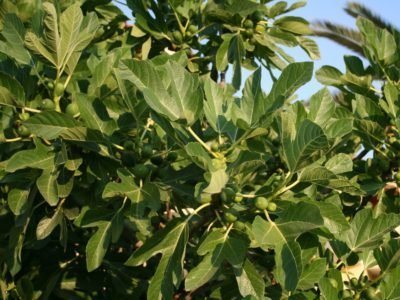

Seedlings, cuttings and figs
You can start growing figs from seeds and cuttings, as well as small trees that are sold in garden centers. But each option has its own advantages and disadvantages.
- Fig Seeds: They are cheaper to buy or get free from ripe figs. This method requires relatively fragile seedlings and even a seeding technique.
- Fig Trees: Purchased from large stores or garden centers and planted directly into the soil. They ripen faster and are less brittle.
- Harvesting cuttings: the most favorable period is the beginning of March. It is necessary to cut the shoot of the previous year into branches of 15-25 cm and plant them in humus-rich soil. Protect from spring frosts and sun, in case of extreme heat.
